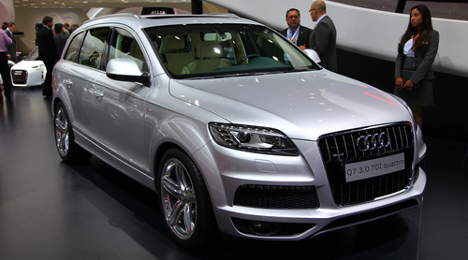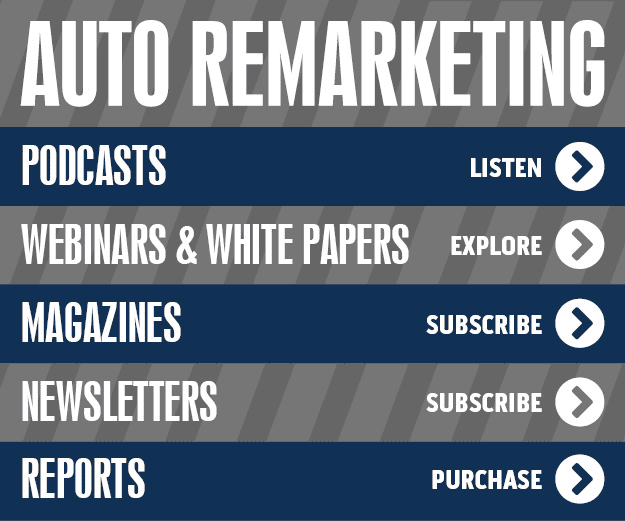Volkswagen, Audi and Porsche announced a stop-sale of certain models in their respective lineups earlier this week following the Environmental Protection Agency’s allegations that the second generation 3.0-liter V6 TDI engines contained a defeat device that circumvents the EPA’s emissions testing.
The stop-sale from the three brands does include their respective certified pre-owned vehicles with the engines — here are the affected models that franchises may still have on their lots as new or CPO vehicles equipped with the affected 3.0-liter V6 TDI engine:
Audi
— 2013 Audi Q7 TDI, CPO
— 2014 Audi A6 TDI, A7 TDI, A8 TDI, Q5 TDI, Q7 TDI; CPO
— 2015 Audi A6 TDI, A7 TDI, A8 TDI, Q5 TDI, Q7 TDI; new & CPO
— 2016 Audi A6 TDI, A7 TDI, A8 TDI, Q5 TDI; new & CPO (the Q7 was absent for this model year)
Volkswagen
— 2013 VW Touareg TDI, CPO
— 2014 VW Touareg TDI, CPO
— 2015 VW Touareg TDI, new and CPO
— 2016 VW Touareg TDI, new and CPO
Porsche
— 2014 – 2016 Porsche Cayenne diesel.
The Porsche data available in the company's news release Tuesday did not specify whether the stop-sale affected only CPO or all used models.
Brad Stertz, the senior manager of corporate communications at Audi of America, confirmed the above new and CPO stop-sales for both Audi and VW.
“The regulators say that it’s okay for customers and dealers to sell used cars still,” Stertz said, referring to the non-CPO variety. “And of course they’re still safe to drive and nobody (the customers) has to do anything until further notice.”
VW’s voluntary recall
Volkswagen announced Wednesday that it notified NHTSA regarding an upcoming voluntary safety recall of approximately 91,800 vehicles with 1.8- and 2-liter turbocharged gas engines from its 2015-2016 model year lineup.
The U.S. models, which include Beetle, Beetle Convertible, Golf, Golf SportWagen, Jetta and Passat, will be recalled due to some vehicles having an issue with the rear camshaft lobe, which has the potential to unexpectedly shear off from the camshaft.
If that happens, vacuum pump power is lost, resulting in the pump not delivering further vacuum supply to the brake booster, reducing engine power and causing the malfunction indicator light to come on.
After depletion of the vacuum reserve, the amount of effort it takes to depress the brake will increase. Reducing engine power and increasing the need for braking effort after the vacuum reserve has been depleted can increase the risk of a crash.
According to VW, no injuries related to this issue have been reported and it will notify all owners of affected vehicles and instruct them to arrange for an appointment at an authorized VW dealer for a remedy at no cost.
Your buyer has scoured the auctions for quality pre-owned vehicles — both in-lane and online — and your dealership now has a great stock of used inventory.
Well, almost; the cars still have to make it through reconditioning to be front-line ready, and any dealer knows this can be time consuming. And of course, this can cut potentially cut into your gross profit.
In light of that, Dennis McGinn, chief executive officer of reconditioning workflow software company Rapid Recon, offered five tips for dealers to cut down on recon time, ranging from speeding up repair approvals to structuring phase times and more.
McGinn explained a productive recon department “runs like an assembly line, using defined processes, timed steps and streamlined communications to produce more output, eliminate waste, and get buyers looking at cars online and on the lot five to 10 days sooner.”
And according to data from NCM Associates, cutting even five days on from this process can improve gross profit. Taking a look at the numbers, if a dealers average recon cycle is eight to 10 days, reducing it to a five-day cycle adds $96 to $160 in gross margin per vehicle retailed, according to NCM.
“Holding costs erode used-car margins, so a faster time to market means more profitable used-car operations,” McGinn added.
The CEO offered these five tips to help used car and fixed operations managers work together more productively and shorten time-to-market:
- Speed repair approvals: Improving communication between recon and the used car manager can reduce bottlenecks. Inability to get a work order approved by the used car manager can delay start of work from a few minutes to a few hours or more.
- Set spend preapprovals: Giving recon some level of authority to proceed with needed work without used car manager approval can keep work flowing uninterrupted. Consider assigning repair dollar “buckets” for vehicles of varying mileage – low, medium, high – based on the mileage and repair averages of the vehicles you recon.
- Structure phase times: Set a time frame for accomplishing specific types of work. Vary times based on the condition of the vehicle. Monitor times and hold staff accountable for adhering to them.
- Compensate for vehicle completion time, not per vehicle: Focus compensation on a production-based measurement. A specified completion time window per vehicle will stimulate parties involved to work smarter and harder to move units through recon in fewer days. Consider spiffs for meeting goals; when considering spiffs, remember the larger picture – reducing holding costs, and turns that improve gross.
- Equip for quality and manage by clock: Make no allowance for less quality work, but beware of tendencies to over-condition. The additional recon cost is rarely recouped and often contributes little to the vehicle’s sales-ability. Pay attention to visuals such as dings and dents, scuffed wheels, glass and other elements that attract buyers’ notice before any mechanical issues might.
Results from eBay Motors’ Future of Automotive Shopping Survey show that nearly 70 percent of consumers have searched for dealership information via their mobile device.
Company officials also pointed out the survey findings indicated consumers — especially younger drivers ages 18 to 29 — expect technology be used to enhance the vehicle-buying experience and are more likely to adopt mobile and online tools to purchase cars, trucks and automotive parts and accessories.
“Mobile is increasingly changing the way consumers shop — whether it’s for a vehicle or parts and accessory,” eBay Motors general manager Sree Menon said.
“Today’s consumer — especially millennials — are embracing technology to enhance their own car shopping experiences,” Menon continued.
“At eBay, we’re continuing to arm automotive dealers and P&A sellers with the tools needed to evolve their business,” Menon went on to say. “We are focused on how we can leverage technology to help sellers create a personalized experience that meets consumers’ ever-changing needs.”
Today’s vehicle shopper is becoming increasingly dependent on technology. In fact, one eBay a car or truck is bought via mobile every five minutes.
Research indicated that consumers are interested in using all available mobile and online resources to make the most informed decision when researching or buying a car as the survey showed 21 percent of 18-29 year olds are interested in trying “augmented reality” when shopping for a vehicle
Women are buying more automotive parts online
With the rise in fitment capabilities, eBay Motors noted more and more consumers purchase P&A online. In fact, on eBay, three P&A are sold every one second.
When it comes to fixing, modifying or upgrading a vehicle, more women prefer to source their part or accessory online. As a whole, eBay Motors thinks today’s shopper is more likely to perform the installation as opposed to paying a professional.
Here are seven other trends listed as findings from latest eBay Motors study:
— 41 percent of women have purchased auto parts (brakes, wheels/tires, interior/exterior components, etc.) online
— Nearly half (47 percent) of consumers have purchased automotive parts online
— 64 percent are DIYers (Do It Yourself) who installed the parts they bought online themselves
— 22 percent are DIFMers (Do It For Me) who bring their parts to an auto shop or dealership
— 14 percent are both DIYers/DIFMers
— 23 percent of the consumers that have not purchased automotive parts and accessories online are likely to do so in the future
— 53 percent of consumers living in the South — included Alabama, Kentucky, Mississippi, Tennessee, Arkansas, Louisiana, Oklahoma and Texas — are more likely to purchase automotive parts and accessories online
The survey conducted in May, collected responses from more than 1,000 U.S. vehicle owners — 50 percent male responses and 50 percent female responses — to determine consumer shopping habits in order to inform what the future of the automotive retail experience looks like.
“eBay Motors is committed to being the leading vehicle, parts and accessories destination, where shoppers can discover and purchase virtually any vehicle they want or parts that they need to modify, repair, and personalize their rides,” site officials said.
Have a GoMoto Digital HUB in your showroom or service bay that you’re looking to easily integrate into your customer relationship management system? Do you utilize VinSolutions’ VinConnect CRM and looking for a way to expand its usefulness? Maybe you even use both?
Either way, VinSolutions announced Monday that the two solutions have integrated, allowing for the customer information entered into a GoMoto HUB to be sent directly to the dealership’s VinConnect CRM tool.
Todd Marcelle, GoMoto’s chief executive officer and founder, commented on the situation in VinSolutions’ release.
"We are excited to announce an integrated customer experience with VinSolutions as they have continually been innovators in automotive,” Marcelle said. “Our partnership will improve the in-store customer experience, streamline the car-buying process and provide powerful data for dealer management to improve performance."
For more information on these two offerings from VinSolutions and GoMoto, visit the VinConnect site here or the GoMoto HUB site here.
Lithia’s leadership has been long touting a goal to average 75 used-vehicle sales per store per month. At the end of the first quarter this year, the group was sitting at roughly 57 units per store.
By the end of September, Lithia’s monthly average has seen a solid gain.
“On a 12-month rolling average, we sold 61 used vehicles per store, up from 55 units in the comparable period last year,” said Bryan DeBoer, the company’s president and chief executive officer. “Our goal to retail 75 used units per store still provides considerable upside in the future.”
Aside from the company’s industrious acquisition strategy, DeBoer says the group is also focusing on strengthening internally.
“We continue to grow used-vehicle sales as inventory resupply increases in the marketplace,” DeBoer said. “Additionally our stores continue to recruit and develop used-vehicle managers with the ability to source, recondition and merchandize used inventories.”
According to the company, several used-vehicle metrics jumped in the third quarter. Here’s a brief breakdown of Q3 same-store results from DeBoer that weren’t specified in the company’s released results:
- Certified unit sales increased 19 percent
- “Core” unit (aged 3-5 years) sales increased 8 percent
- “Value Auto” unit (mileage over 80,000 miles, any age) sales increased 5 percent
With its used-vehicle sales leading the way in revenue stream increases in Q3, DeBoer also mentioned that the company’s used-to-new sales ratio was brought up to 0.83:1.
So how will the seasonal trend of increased supply affect Lithia’s pricing scheme?
“If we look at residual values and we look at what we believe will be future trends, what we're starting to see initially is that there’s starting to be increase supplies in used vehicles,” DeBoer said. “So off-leased vehicles are becoming more prevalent, which would give indication that values may soften a little bit as supply begins to loosen. And I think those trends may continue as the SAAR rates continue to climb as well.”
Sidney DeBoer, the company’s founder and executive chairman, agreed on the pricing situation and clarified his outlook.
“This is kind of a stable position that we’re in now,” he said. “There are no extremes.”
Speaking of lease returns and the large contingency of them anticipated to hit the market, an analyst asked if that would affect the number of used inventory units that Lithia will hold on to.
“Personally, I don’t think so,” Bryan DeBoer said. “I think that helps you grow your business but I don’t think you’re going to reduce your overall inventories because of that because we’re still trying to grow core and valued autos, as well. And remember, core is over half of our business. So even as those off-lease cars grow, I really believe no, it’s not going to affect the inventories.”
DCH integrating well
Lithia’s purchase of one of the largest dealer groups in the country, DCH Auto Group, closed a little over a year ago, representing one of the largest dealership acquisitions in recent history. Using a baseball metaphor this week, DeBoer says it may very well be one of the most painless purchases Lithia has ever made.
“In terms of what inning we’re in, in terms of integration, I would say that we’re in the middle innings. I believe they know who they are and what they want to become,” DeBoer said. “They have a wonderful culture. They are humbly confident, much like we had talked about.
“And I can say this: I think it was the smoothest integration that we may have ever had on an acquisition, including the small ones that were $30 million. This, at $2.4 billion, was really pleasing to see that our two organizations, who if you recall knew each other historically but never were really together at this level, we’re proud to have them as our teammates and companions.”
Want to read more on Lithia’s ongoing acquisition strategy? Check out our story here.
Twenty-six hundred stores. As Auto Remarketing reported earlier this year, that is the number of dealerships nationwide that Lithia Motors' president and chief executive officer Bryan DeBoer maintains his company has on his radar as potential acquisitions.
With three third-quarter acquisitions under its belt, one of which includes the only Acura store in Honolulu, DeBoer said the fourth quarter is starting strong – with yet another purchase.
“The fourth quarter is off to a good start with the acquisition of Concord Chrysler Jeep Dodge Ram and Fiat in California,” DeBoer said in the retailer's recent quarterly earnings call. “Thus far in 2015, we have purchased or opened six locations with estimated annual revenues of approximately $220 million.”
Playing into the role of the group’s acquisitions are its earnings milestones. Following a milestone set by the company earlier this year of $7 per share, which the company anticipates exceeding early next year, Lithia’s management team went ahead and raised the bar a bit higher — to $8. What’s needed to reach it? More stores, more sales.
“To get to the milestone eight, we need about a billion dollars in additional acquisitions in revenue,” DeBoer said. “That’s something that we’re going to be looking at. I believe that could come before a recession would ever possibly hit.”
DeBoer mentioned that his company spends about half of its time looking at acquisitions to support its DCH strategy, focused on metropolitan areas.
The CEO says Lithia has looked at roughly 30 deals in the Tri-State area surrounding New York City and in Southern California. He said the retailer is pretty close sealing the deal on a few sizeable deals, which he said are larger in size compared to Lithia’s average-size acquisition.
He said the retailer is pretty close sealing the deal on a few sizeable purchases, which he said are larger in size compared to the average acquisition that Lithia makes.
When asked if Lithia was focused on larger buys, picking up smaller stores, or some mix in-between, DeBoer appeared open to any possibility.
“I think what we’re seeing is that there is a ton of opportunities, so we’re able to be selective on not only large groups but on our individual groups,” he said. “So far this year, we’ve done six acquisitions or open points. We really believe that the pipeline is full and that was maybe a little bit slower than what we would expect in the future.
“And I think it’s because there is such a vast array of selection. When we look at whether or not there are going to be a stable diet of one or two type of stores, I think we will have a balance of those.”
Chris Holzshu, Lithia’s senior vice president and chief financial officer, focused on making sure the company is prepared to make acquisitions when the timing is right.
“Looking forward, as we keep talking about acquisitions and being in the next phase of our growth plan, I think it’s important for us to make sure that we have a balance sheet that can acquire a significant number of stores if they come to market,” Holzshu said. “Before DCH, our leverage ratio was about 1.3 times.
“So, we’ve still probably got another year to get down there assuming that we don’t do a lot of acquisitions. But I think we feel that the acquisition pipeline is full right now and our leverage ratio will probably at least stay where it’s at or climb a little bit through next year.”
Maintaining a forward-looking approach, DeBoer commented on how even negative economic climates can present opportunities for Lithia to capitalize to continue its growth plans.
“I still think the biggest driver of acquisitions is that we went through a decade, or a half of a generation, of depressed values because of the recession,” DeBoer said. “I think that’s what’s really driving it. I think if there is some type of gloom, to some extent, like what happened a few months ago with the stock market, like what may happen again, that those type of events can be elixirs to creating more acquisitions.
“Right now there is just so many out there that the ability to be selective has been really good from our standpoint. And I think that has a pretty good runway for the next five to 10 years that we’ll continue to see that.”
The Prime Motor Group announced Friday its extensive expansion plans in Westwood and Rockland, Mass., with groundbreaking ceremonies having taken place in early October to make way for four new dealerships in the Boston area.
Three of those four dealerships broke ground side by side on Oct. 1 in Westwood, making way for over 120,000 square feet of space situated on 12 acres of land along Route 1. Positioned adjacent to Prime’s Mercedes-Benz of Westwood, the three luxury dealerships will retail Audi, Acura and Porsche vehicles.
Each dealership will feature a full service café, lounge areas, indoor service drives, Wi-Fi accessibility and quiet areas for customers who’d like to work while they wait for their vehicle service to be completed. Combined, the dealerships will include 70 service bays along with a fleet of complimentary loaner vehicles.
The three dealerships will incorporate Prime’s existing Acura, Audi and Porsche staff and clients when it opens at an anticipated date of July 2016. The group plans to add approximately 25 jobs with the expansion, bringing the group’s total employee number to 180.
"We opened our original Audi and Porsche dealerships in Westwood and our Acura dealership in Walpole in 2007,” said David Rosenberg, the group’s president. “Over the past eight years we've grown and improved the operations significantly. Quite simply, we need more space to better serve our customers. The timing was right and the town of Westwood has been extraordinary to work with as we've developed our plans."
Matt McGovern, the group’s vice president, says that putting the four dealerships in such proximity will allow for a unique luxury shopping experience.
"By having Acura, Audi and Porsche immediately next door to our existing Mercedes-Benz dealership, customers in search of a luxury vehicle will have four outstanding brands to explore, all in easy walking distance of each other,” McGovern said. “We are creating one of the few settings in the country to offer customers the opportunity to test drive and compare multiple brands of luxury vehicles at one convenient destination."
Looking eastward to Rockland, Mass., Prime broke ground on Oct. 2 for its new Hyundai dealership, which will eventually feature 27,000 square of sales and service space. The group anticipates an opening date in May 2016 with roughly 50 people on staff.
"For the past two years we've been looking for an exceptional South Shore location for a new Hyundai dealership,” Rosenberg said. “We first opened Hyundai in Quincy in 2012 and while we loved being there, the footprint of the facility was extremely limited and couldn't be expanded upon. From the customer's perspective, we felt we needed to be more accessible, and Rockland delivers that beautifully as we'll be situated right off Route 3. We'll also have far more room both for customer parking and additional inventory to better serve the local communities."
For more information on the Prime Auto Group, visit its site here.
For dealerships, trade-ins are often a valuable — and coveted — source of quality used inventory.
With that in mind, tech company CARPHORIA announced Monday it has grown its dealer services offering with a new tool: Trade-In Valet.
The new tool is designed to help dealers capture more consumer trade-ins, and is based on consumer behavioral modeling.
Here’s how it works: the new subscription service works through a dealer app that is embedded on the store’s website. Consumers can enter their trade-in info and receive an offer range via email before coming into the dealership, helping them better understand the value of their existing vehicle.
Oftentimes, trade-in pricing can be one of the biggest pain-points of the new-vehicle purchase process as many shoppers might not understand why the trade-in value for their vehicle is lower than they originally expected.
"It's a fact. Buying a vehicle is no longer an old-school operation. Today's buyers are more sophisticated than ever and require far more information before they are willing to award their business to a particular dealership," said Michael Dodd, chief executive officer of CARPHORIA.
"Every study we read indicates that today's consumers want a stress-free sales process from dealers willing to sell the way they want to buy. Trade-In Valet does just that. Consumers get the information needed to make a well-informed decision while dealers receive the tools and processes in order to meet consumers' shopping demands. The end result? Higher retail deliveries and gross profit with happier customers,” he continued.
The Trade-In Valet tool and buy-back service uses unique vehicle data in order to provide the true value of each vehicle, company management shared.
"Dealerships that understand there is a new way of doing business and embrace the consumer evolution are ending up the clear winner in the competition for consumers business. It isn't the lowest price that today's consumers are looking for, it is about information, experience and trust," said Dodd.
What cars do owners hold onto the longest?
Besides the fact that vehicles are lasting longer today than ever before, this is a valuable question — a question whose answer could potentially increase service revenues and make valuable trade-in prospects.
iSeeCars.com took a look at over 395,000 used cars from model year 2005, sold by the original owner between January 1 and July 30 of this year, to get a better understanding of what kind of vehicles were reaching the decade mark by these original owners who bought the cars new.
Looking at the iSeeCars chart below, you’ll see the 15 models among the 168 models studied that were kept the longest, all at least 1.5 times or more likely to be held onto than the average vehicle (which came in at 13.5 percent overall).
Top 15 New Cars Owners Hold Onto for 10 Years
| Rank |
Model |
% Original Owners Holding Car for 10 Years
|
Compared to Average |
| 1 |
Honda CR-V |
28.6% |
2.1x |
| 2 |
Toyota Prius |
28.5% |
2.1x |
| 3 |
Toyota RAV4 |
28.2% |
2.1x |
| 4 |
Toyota Highlander |
26.5% |
2.0x |
| 5 |
Honda Odyssey |
25.6% |
1.9x |
| 6 |
Toyota Sienna |
25.4% |
1.9x |
| 7 |
Toyota Camry |
24.4% |
1.8x |
| 8 |
Toyota Avalon |
23.8% |
1.8x |
| 9 |
Honda Pilot |
23.3% |
1.7x |
| 10 |
Honda Element |
23.1% |
1.7x |
| 11 |
Subaru Forester |
22.9% |
1.7x |
| 12 |
Toyota Matrix |
22.6% |
1.7x |
| 13 |
Honda Accord |
22.1% |
1.6x |
| 14 |
Toyota Corolla |
21.5% |
1.6x |
| 15 |
Toyota 4Runner |
21.1% |
1.6x |
| |
Average of All Cars |
13.5% |
— |
Some quick takeaways you’ll notice: they’re all from Japanese automakers. Nine are Toyotas. Five are Hondas. One Subaru.
That’s not the surprise, however, according to iSeeCars.com’s chief executive officer, Phong Ly. The surprise comes from their segment makeup.
Ten out of the 15 vehicles are CUVs or minivans, with four out of the top five falling into either one of those two categories.
"These vehicles tend to be largely family cars, so if people buy these cars when they are just starting their families, it stands to reason that these cars would suit them for many years," Ly said in an analysis of the data.
Another key takeaway, according to iSeeCars, is the weak showing by what they see as the most popular vehicles from the list of fledgling double-digit ownership.
% of Owners Holding Onto Popular Cars
| Model |
% Original Owners Holding Car for 10 Years |
Compared to Average |
| Toyota Camry |
24.4% |
1.8x |
| Honda Accord |
22.1% |
1.6x |
| Honda Civic |
18.2% |
1.3x |
| AVERAGE |
13.5% |
— |
| Chevrolet Silverado 1500 |
13.1% |
1.0x |
| Nissan Altima |
13.1% |
1.0x |
| Dodge Ram Pickup 1500 |
11.7% |
0.9x |
| Ford F-150 |
11.4% |
0.8x |
| Ford Escape |
10.9% |
0.8x |
| Chevrolet Equinox |
10.0% |
0.7x |
| Jeep Grand Cherokee |
9.5% |
0.7x |
The list is especially devoid of one of North America’s favorite vehicle types, the pickups.
"One reason that may be is because these cars are often used as work vehicles, such as in construction,” Ly said. “Work vehicles log many more miles than average, likely requiring them to be replaced sooner.”
On that same note, Ly also speculates that the absence of domestic brands in the most-held-onto group might be a result of them not having the same reputation for reliability that the Japanese brands typically garner.
The bottom of the overall list is riddled with domestic vehicles that are typically known for their use in commercial fleets or as rental vehicles, including the Chevrolet Impala, Chrysler Sebring and the Ford Taurus, or vehicles that make popular lease choices, like the BMW 5 Series.
"All of those markets are designed for cars that are no more than a few years old, so a decade after these 2005 cars were introduced, most of them would be sold by their second or third owners, rather than the original owners,” Ly said.
According to Ly, car shoppers can sometimes find the most value in these older vehicles that have been kept by a single owner.
"Cars kept by the original owners for a decade tend to be well-cared-for, in terms of actual maintenance and repairs as well as overall cleanliness, so a car shopper is likely to find more value than in a car that has been through multiple owners and with a history that may not be so straightforward,” Ly said.
Selectbidder, a Canadian auto tech company best known for its auction-centric dealer trade networking platform for trade-in vehicles, launched its product in the United States market last month and officially announced its first American auction partner on Tuesday.
Eighteen-hundred miles away from Selectbidder’s Moncton, New Brunswick home is Melbourne, Fla.-based Space Coast Auto Auction, who will utilize the Selectbidder platform to orchestrate real-time bids for its network of dealers handling trade-ins.
How exactly does it work? To put it simply, the Selectbidder platform takes an auction’s already established network of dealers and connects those with recent or pending trade-ins to other dealers interested in buying them.
Joe Pritchett, Space Coast’s chief executive officer, explains his reaction to the solution, which was recently demonstrated for him at the 2015 NAAA Convention in Orlando, Fla.
“Once we saw how Selectbidder puts our auction into the trade-in process, I knew we needed to start using it,” Pritchett said. “With Selectbidder, our selling dealers are going to deal with us at the point of trade, allowing us to sell more cars straight from their lots. Our dealers and their customers are going to love how quickly and easily they get live offers on their Trade-ins. For our dealer buyers, it’s going to allow them to tap into fresher vehicles earlier in the remarketing process.”
Basing the system around what Selectbidder considers the “original dealer network” – the auction – the company aims to increase transparency for everyone involved, including the customer, who can see for themselves how much the dealer will receive for the trade-in vehicle at the next step in the sale cycle.
In a previous interview with Auto Remarketing, Selectbidder chief executive officer Sean Liptay said he hopes this is just the beginning of his tech-company’s growth in the U.S.
“The beauty of the product is that it can be up and running within a week in any location in North America, based around surrounding independent auctions,” Liptay said. “So it doesn’t matter if it’s the local auction in Florida versus the local auction in Louisiana, they can be up and running because they already have the relationship network built.”
Interested in reading more about Selectbidder and other companies making noise in the auction industry? Stay tuned for our Oct. 15 issue of Auto Remarketing, both in print and online, where we delve further into the topics of digital trends, tools and strategies for the wholesale market.
Editor Joe Overby contributed to the reporting for this story.












